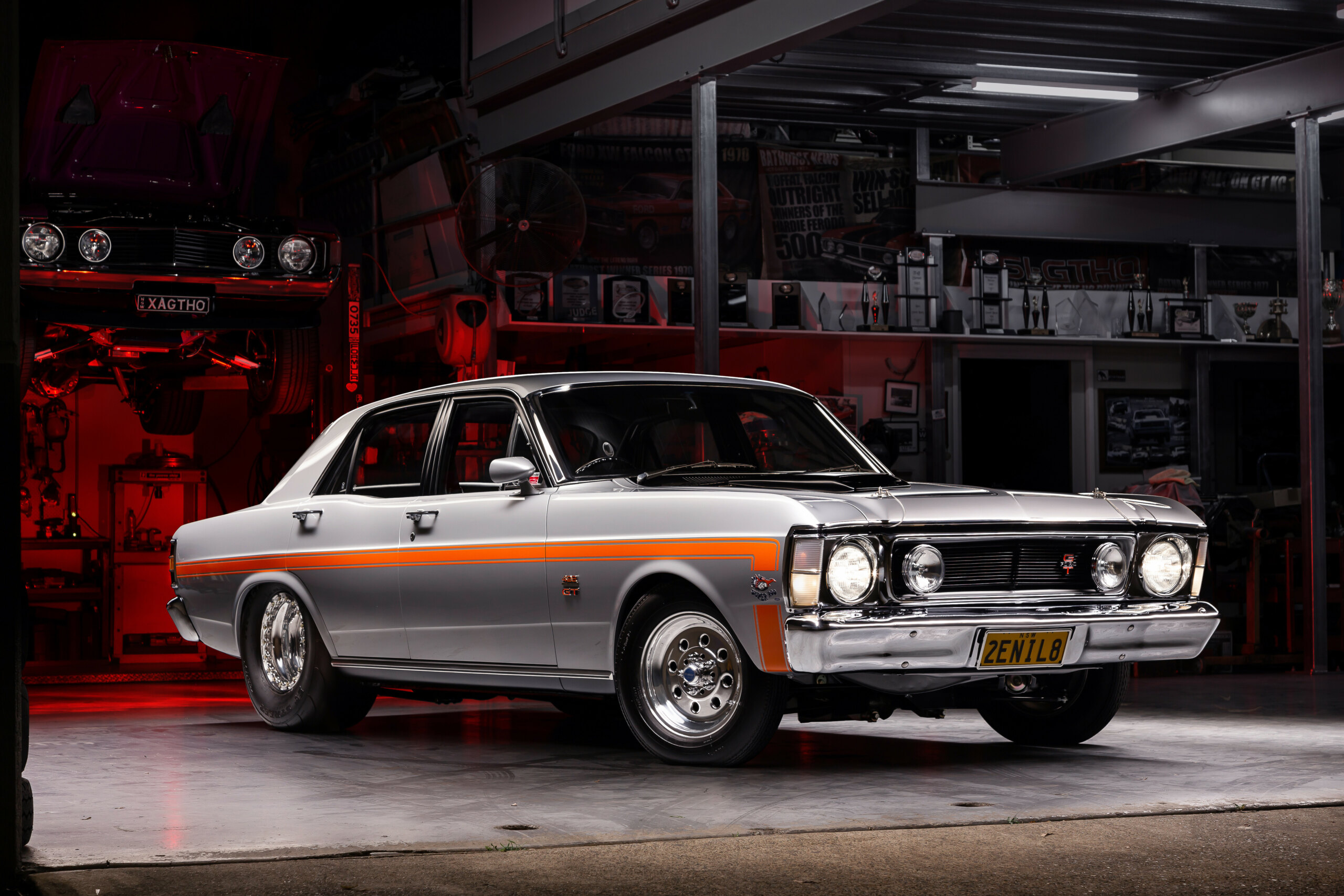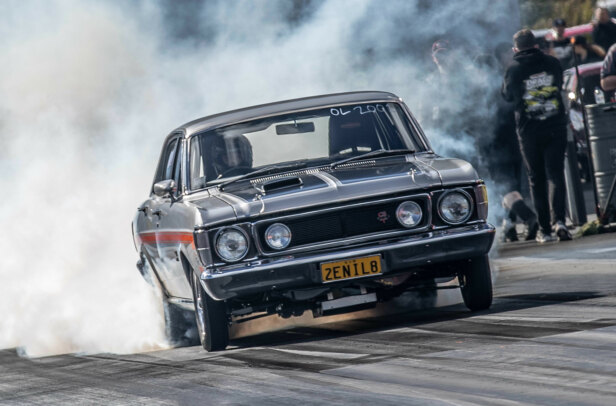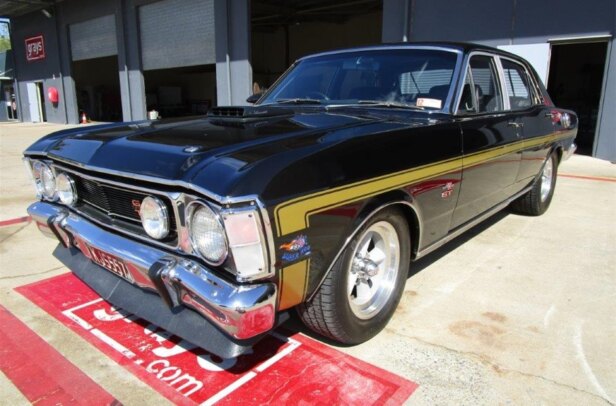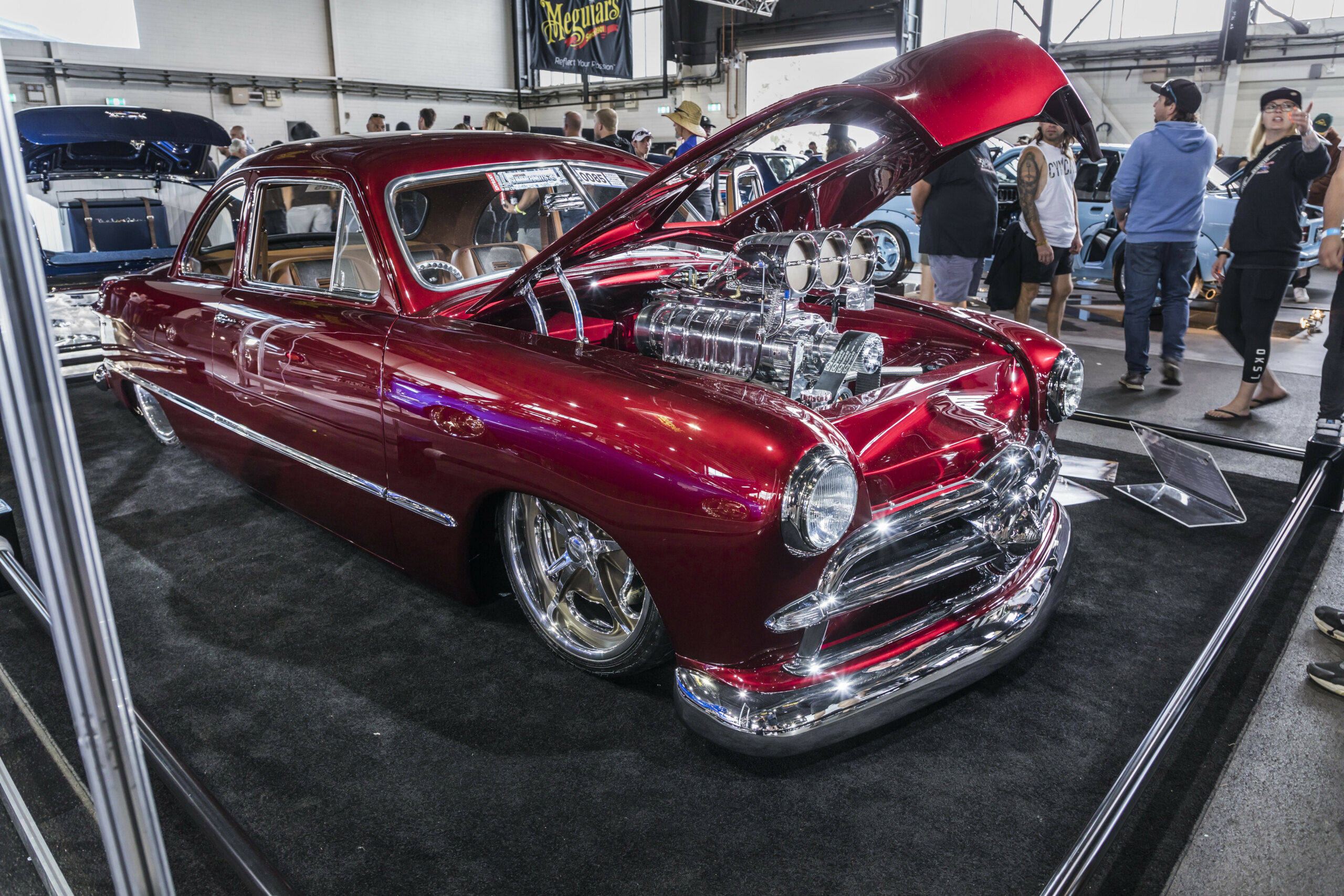IF CARS could talk, Jason Mansweto’s 1969 Falcon would have an epic tale to tell. If you’re already across 2ENIL8’s back-story and thinking that what you see here is just the old XW freshened up, you’re in for a few surprises!
First published in the January 2022 issue of Street Machine
Jason’s XW is now a mix of concours contender, Elite showstopper, jaw-dropping pro streeter and insane seven-second strip terror. “If Ford Australia ever offered a drag pack, that’s what I wanted it to look like,” Jason says.
Let’s start with the elephant in the engine room. Built by Jason himself, aka Mansweto Racing, the 652-cube behemoth uses a Premier block based on Ford’s 429/460 big-block. To get to 652 cubes, the bores were hogged out to take 4.675-inch Diamond pistons swinging off a 4.750-inch Callies crank. Feeding this insatiable beast is a solid-roller cam, with a pair of heavily modified Trick Flow heads up top.
Jason built two intake systems: a Pro Systems, single-butterfly SV1 atop a Trick Flow A460 intake for the street, and twin Pro Systems 1150 Dominators on a Trick Flow tunnel ram for the track.
Both systems yielded promising results on the dynamometer. “My goal was to make 1200hp NA, so I started with the twin fours,” says Jason. “It cracked 1200 so easy; I didn’t really chase it. When I swapped to the single, I was very surprised with what it made.”
On a 98 PULP-friendly tune, the single-carb set-up churned out 950lb-ft and 1189hp! And with the twins bolted on and VP109 in the tank, it’s far healthier than the current 1204hp the dyno sheet indicates. Oh, and let’s not forget there’s a solid 500hp worth of nitrous at the ready!
The rocker covers are an example of the lengths Jason has gone to achieve that factory look. While common on 289/302 Windsors and FE big-blocks, this style of ‘Power by Ford’ covers are ultra-rare for the 429/460 big-blocks. “I searched for ages for a set,” he says. “When they finally arrived, they were badly battered and partially squashed. I spent a lot of hours bodyworking them back into shape.”
To give those cavernous 2.5-inch primaries some breathing room, the towers were carved out, trimmed and neatly welded back in quite a few millimetres further apart. Moving the towers outwards did the same to the wheels, so to tuck them back in, the uprights were modified, the bearings were sunken into the hubs and the 3.5-inch front rims were modified.
The engine bay has been smoothed and refined, but with a factory look. The new inner guards incorporate original-looking swage lines, while the radiator support was smoothed using sections cut from a donor support. The panelling behind the driver’s side headlight was cut out to allow airflow into the trans cooler that’s tucked in behind.
Behind the mega-mill is a Protrans-built Reid-case Powerglide that can cope with the combo’s 1700+hp max output.
Jason’s good mate, Con Constantinou from Pro Street Metalcraft, was a tremendous help throughout the build. “He did all the TIG welding,” says Jason. “He and I think the same, with Con contributing a lot of great ideas to the build.”
The sheet-metal diff Con fabricated is a veritable work of art, filled with a Mark Williams aluminium centre; 3.4:1 Pro gears; 40-spline, gun-drilled axles; and a full spool.
Rather than tub the car to within an inch of its life, Jason went the more subtle route to accommodate the portly 315/60R15 Mickey Ts. The springs were moved inboard of the chassis rails, the inner wheelwells were widened (with a factory look), and the length of the wheelarch was stretched 75mm. To maintain the original wheelbase, the dogleg was moved forward and the trailing edge moved backwards.
While essentially being the only exterior body mod, moving the dogleg required modifying the door skin, door frame and sill mould, which was shortened and re-welded. Only the most ardent XW/XY trainspotter would pick it, though.
To get a full-steel Falcon down the quarter quick-smart, you need lots of traction. To plant the rear tyres, there’s Calvert split mono-leaf springs, CalTracs and AFCO Racing shocks, plus Gazzard Brothers sliders and anti-roll bar. The front is far simpler: Pedders springs and 50/50 shocks.
Pop the boot and you’ll note the complete lack of cover panels. Everything is on display, yet it looks super-sanitary.
After the NOS quarters were chopped up to stretch the wheelarches, their insides were bodyworked, smoothed and painted to the same quality as the exterior. This insane level of effort and attention to detail is repeated endlessly from bumper to bumper – there’s not enough space here to cover it all.
The GTHO’s long-range, 36-gallon fuel tank used two bottom halves joined together. Jason took this idea, flipped the XW’s original fuel tank upside down and fashioned a factory-looking flat bottom from sheet metal. Before welding it together, an elaborate baffling system was added for the fuel pick-up. Its design was inspired by the baffles typically seen in circuit racing engine sumps.
The 2300hp-capable Aeromotive Eliminator pump is mounted inside the tank, with the short braided line from the tank to the body about the only visible fuel line in the whole car. The pressure reg is mounted on the firewall behind the engine, while the return line runs back through the sill, dumping into the top of the fuel filler pipe.
2ENIL8’s sensational body and paint is thanks to Steven Nikolovski (body) and Con Kakoliris (paint), both from Panel Worx.
The talented duo pretty much worked full-time on the Falcon for a whole year. With paint supplied by PPG, it isn’t just good on the outside – the finish is just as nice in all the places you can’t see!
As stated earlier, 2ENIL8 has been built like a concours car. Componentry like the door locks, boot lock, seat runners, bonnet catch, door hinges and wiper mechanisms were all disassembled, painstakingly restored and re-plated or repainted as per factory.
Don’t be fooled by the interior’s near-stock appearance; there’s plenty going on in there. Under the dash are two brake boosters and three master cylinders: front brakes, rear brakes and handbrake. The original mechanical pull handle operates a master cylinder that activates the rear Wilwood four-piston calipers. “This way I didn’t have any handbrake cables under the car,” says Jason. “And like all the fuel hoses and wiring, the hydraulic brake lines are also hidden out of sight.”
The brake pedal started life as the standard Wilwood swing-mount assembly. The Wilwood foot pad was removed and replaced with a fabricated aluminium version that accepts the factory XW rubber pad.
The original T-bar shifter and illuminated shift indicator work harmoniously with the Powerglide, while the nitrous controller and battery have been shoehorned into the glove box!
While admiring the later-model XA/XB retractable seatbelts that have been retrofitted with XW buckles, did you happen to notice the ANDRA-teched 12-point rollcage? It’s tucked in so tight it’s hard to see from the outside. Con from Pro Street Metalcraft added an extra six ‘points’ to a six-point ’cage, with a crossbar tucked way up under the dash and bars that run out through the firewall to the shock towers. He also added diagonals that run behind the front seats from the roll-over hoop down to the chassis connectors.
To further enhance rigidity, there’s a rear engine plate, and chassis connectors that are fully welded into the body and tied into the rear rails (which have been fully gusseted and plated). The rollcage, rails and connectors all tie in together to form an incredibly rigid structure.
While 2ENIL8 is now way nicer than any factory-delivered vehicle, Jason is adamant that he still wants to run a time in it.
“It’ll never be my race car again,” he says. “However, it makes more power naturally aspirated than it did on gas when it ran 8.8. It’ll run well into the eights; then I’ll keep pouring nitrous into it until it runs a seven!
“I’ve always built race cars, but I always knew I could build a show car,” Jason concludes. “That’s why I built a show car that could run sevens!”
Now that’s winning!
RISE OF THE MACHINE
JASON bought the Falcon in 1987, when he was just 14. The 1969 XW still had its 302 and Lime Frost Metallic paint. By the time he had his P-plates, Jason had rebuilt it, painted it white and added a tough 351 Windsor. It ran 12.50s at the Eastern Creek drags. “That’s where I caught the racing bug,” he says.
In ’96, it was revamped and came back blue with AGR069 plates. It featured on the cover of Performance Street Car, while its 351W underwent many years of development. AGR069 eventually ran a best of 10.70@126mph in 1997.
The dawn of the new millennium saw the Falcon undergo yet another facelift before coming back as 2ENIL8. The now-Silver Fox XW proceeded to rack up accolades, starting with a Street Machine cover story in November 2001. It was a two-time Summernats Horsepower Heroes champion, winning the Naturally Aspirated Small-Block class by a landslide with a radically modified 440-cube Pro Stock-style Windsor that made 620hp at the wheels. Next was a more streetable 380-cuber that ran 10.1@133mph, followed by a far more serious 451 Windsor that made 790hp NA and over 1100hp with a 300-shot of nitrous, producing 2ENIL8’s best ET of 8.80@156mph.
Jason had only run two passes with that motor when he tapped the wall at Powercruise 2008. The car has been off the road ever since, gradually undergoing the full rebuild you see here.
JASON MANSWETO
1969 FORD XW FALCON
| Paint: | PPG Silver Fox |
|---|---|
| ENGINE | |
| Type: | 652ci Ford big-block |
| Intake: | Trick Flow R-Series A460 (street), tunnel ram (race) |
| Carbs: | Pro Systems SV1 (street), twin 1150cfm Pro Systems Dominators (race) |
| Heads: | Trick Flow A460 |
| Camshaft: | Crow solid-roller with .906in lift |
| Conrods: | Reher-Morrison |
| Pistons: | Diamond 4.675in |
| Crank: | Callies Magnum 4.750in |
| Sump: | Jeff Johnston’s Billet Fabrication alloy (modified) |
| Oil pump: | Titan twin pick-up |
| Fuel pump: | Aeromotive Eliminator |
| Cooling: | Alloy radiator |
| Headers: | Custom 2.5in primaries into 5in collectors |
| Exhaust: | Four mufflers with 5in and 4in pipes |
| Ignition: | MSD Digital-7 Plus, MSD crank trigger, ICE 1000-Series leads |
| Fuel: | 98PULP (street), VP109 (race) |
| TRANSMISSION | |
| Gearbox: | Protrans Reid-case Powerglide |
| Converter: | Dominator 6500rpm stall |
| Diff: | Fabricated chrome-moly 9in, Mark Williams alloy centre, 40-spline Mark Williams axles, 3.4:1 Pro gears |
| Tailshaft: | Mark Williams 3.5in |
| SUSPENSION & BRAKES | |
| Steering: | Cortina rack-and-pinion |
| Front: | Pedders springs and 50/50 shocks |
| Rear: | Calvert split mono-leaf springs, AFCO shocks, CalTracs, Gazzard Brothers anti-roll bar |
| Brakes: | Wilwood four-piston (f & r) Pedals/master |
| cylinder: | Wilwood pedal box, twin boosters |
| WHEELS & TYRES | |
| Rims: | Weld Draglite 15×3.5 (f), Weld Draglite with custom beadlock 15×10 (r) |
| Rubber: | 5.6x26x15 (f), Mickey Thompson 315/60R15 |
THANKS
Con Constantinou and Adam (Pro Street Metalcraft); Steven Nikolovski and Con Kakoliris (Panel Worx); Fred (Protrans); Jason and Damien Lowe (Lowe Fabrications); Paul Zammit (wiring); Shane (Ford Muscle Parts); good mate Matt King for always being there and being a big part of the car’s history; my friends and family for the support, especially my partner Doreen Bugeja




Comments